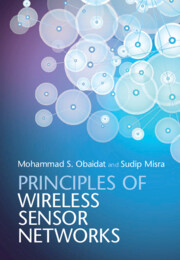Book contents
- Frontmatter
- Dedication
- Contents
- Preface
- 1 Introduction to wireless sensor networks
- 2 Inside a wireless sensor node: structure and operations
- 3 Wireless sensor network applications: overview and case studies
- 4 Medium access in wireless sensor networks
- 5 Routing in wireless sensor networks
- 6 Transport protocols for wireless sensor networks
- 7 Localization and tracking
- 8 Topology management and control
- 9 Performance evaluation of wireless sensor networks
- 10 Security issues in wireless sensor networks
- 11 Wireless mobile sensor networks
- 12 Wireless multimedia sensor networks
- 13 Underwater sensor networks
- 14 Wireless underground sensor networks
- References
- Subject index
- References
3 - Wireless sensor network applications: overview and case studies
Published online by Cambridge University Press: 05 December 2014
- Frontmatter
- Dedication
- Contents
- Preface
- 1 Introduction to wireless sensor networks
- 2 Inside a wireless sensor node: structure and operations
- 3 Wireless sensor network applications: overview and case studies
- 4 Medium access in wireless sensor networks
- 5 Routing in wireless sensor networks
- 6 Transport protocols for wireless sensor networks
- 7 Localization and tracking
- 8 Topology management and control
- 9 Performance evaluation of wireless sensor networks
- 10 Security issues in wireless sensor networks
- 11 Wireless mobile sensor networks
- 12 Wireless multimedia sensor networks
- 13 Underwater sensor networks
- 14 Wireless underground sensor networks
- References
- Subject index
- References
Summary
Wireless sensor networks (WSNs) have fascinated both the research and development communities. Applications of WSNs have mushroomed in both civilian and military domains. The growth of wireless sensor networks was originally motivated by military applications; however, WSNs are now used in all kinds of civilian and industrial applications [1–20]. Currently, the overwhelming majority of WSNs measure scalar tangible phenomena such as humidity, pressure, temperature, movement, and pollutants. Typically, most WSNs are built for delay-tolerant and low-bandwidth applications. Hence, most research efforts have concentrated on this latter paradigm, which is often called terrestrial sensor networks. In any WSN application the main challenge is the lifetime of the network. A WSN structure includes a gateway that offers wireless connectivity back to the wired/fixed network.
In nearly all applications of the WSNs, they are used to monitor certain physical processes. They are deployed for measuring the temperature, air pressure, radiation of the human body, chemical reactions, movement of objects, vitals of the body, and so on. By doing this we can recover some important information of the boundaries that are often called edges. To keep track of the edge of a physical development, the recognition of a boundary is imperative. The issue of discovering the boundary is considered to be the first step for resolving the edge detection. In digital processing there are many methods for identifying the edge; however, they are not easy to implement in the WSNs’ environment since the sensor nodes are not equally spaced like pixels, and because of limited computational power and memory [3–6].
- Type
- Chapter
- Information
- Principles of Wireless Sensor Networks , pp. 30 - 47Publisher: Cambridge University PressPrint publication year: 2014



